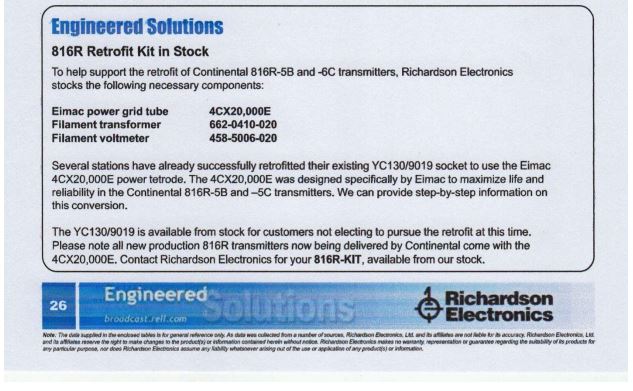When Eimac and Continental Shared a Tube and Transmitter Fiasco
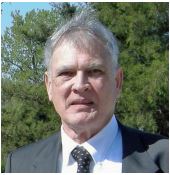
[August 2018] When designing and building transmitters, it take a lot of cooperation and communication to make things work. Reid Brandon recalls what happened when some of that did not happen.
The history of the Eimac 4CX40,000G broadcast tube is an interesting one, coming at one of the darkest chapters in the company’s past.
That tube was fraught with problems after it was designed into an FM broadcast transmitter at Continental Electronics Corp (CEC) in Dallas in the early 1980’s. Then, after only five years in production, both the tube and the transmitters that used it would be discontinued.
1980’s High Power FM
In the early 80’s, FM broadcasting was moving up to higher power and there were lots of opportunities for higher power transmitters as stations were upgrading their systems. At that time, Varian owned Eimac and it was part of their Electron Device Business.
CEC acquired the design rights to the cavity, developed by Collins Radio in the late 1970’s, from Rockwell- Collins in order to move swiftly into the FM broadcast market (Rockwell wanted to concentrate on military programs as its major business thrust, just as Varian would at a future date).
The Collins design used a 4CX15,000A, a relatively inexpensive tube due to large production rates since it was being used in many other applications. It was truly a “general purpose tube.”
Rockwell-Collins designs had pushed the output power of the 4CX15,000A to over 27 kW (in the 831-G3 model). But the tube life was proving to be less than ideal.
Looking For Higher Power
Thus, CEC engineers undertook the development of a one-tube 60 kW FM transmitter, introducing it at the NAB show in 1983. It would become their model 817A.
Ken Sides, the CEC Design Engineer, chose Eimac’s 4CX40,000G for the new design.
The 4CX40,000G featured pyrolytic graphite grids (PG for short), a relatively new material being used in power grid tubes. PG had several desirable characteristics, one was the near-zero coefficient of thermal expansion, meaning the physical shape remained precisely the same even when was heated to very high temperatures, and PG grids would not melt or warp as wire grids did under extreme conditions.
Eimac had developed a laser cutting system that permitted uniformity and precision grid dimensions
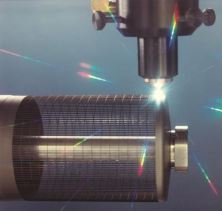
Laser Cutting A Pyrolytic Graphite Grid Cup
(courtesy Pete Nuding Photography)
Sad to say, even though the process was mechanized, the cost per grid was many times more than conventional wire grids and that led to a 4CX40,000G costing significantly more than a pair of 4CX15,000A’s.
The 4CX40,000G also was a massive tube, at 55 pounds, four times heavier than a 4CX15,000A which weighs a little under 13 pounds.
A Decent Pedigree
The design itself seemed to be more than sufficient.
Eimac had been supplying a similar te-trode with PG grids for use in 50kW SSB transmitters – the 4CX40,000GM (G indicating Graphite and M for Marconi, the well-known UK firm). The only difference between a 40,000-G and the -GM was a slightly different grid pattern for better IMD performance in the -GM, otherwise the two tubes were identical.
It should be emphasized at this point in the story that the 40,000GM was a very reliable product, with none of the tubes supplied to Marconi ever failing or were returned for any reason. It should also be revealed here that Thales, the great French tube company, had licensed Eimac to use PG for grids, and several Eimac high power tetrodes successfully used PG grids for high power shortwave broadcast service.
The 40 KW Tetrode Fiasco
Nevertheless, complaints began coming in soon after CEC started delivering 817A transmitters.
Customers were unhappy about the input tuning drift – most station engineers were going to their transmitter sites almost daily to retune the input circuit.
Therefore, CEC sent their prototype 817 transmitter to Eimac to reduce the time required to evaluate tube changes, as well eliminating any delays in shipping tubes between California and Texas.
Dave Meacham, an Eimac staff engineer in the Advance Product Development Lab, believed the high Q associated with the input circuit was responsible for the tuning drift. He suggested using a stepped-impedance transmission line for the grid input circuit.
However, Ross Faulkner flatly rejected that proposition.
Oddly, one of the 817A transmitters using the 4CX40,000G was operating fine. But all the other stations had tube problems.
Some tubes failed catastrophically with internal shorts and broadcasters attempting to find replacement tubes were told Eimac was unable to make them fast enough – being a relatively new tube type they had none in stock, anywhere.
The Finger Pointing Begins
Of course, Eimac received all the blame for the problem.
As to the internal shorting phenomenon, it was discovered an insulator disc located between the top of the screen and control grids was melting in the high RF field there. John Mark, Eimac’s Chief Engineer at the time, had a tube built with an industrial sapphire insulator instead of the conventional alumina, but it failed also – not surprising because its melting point was even lower than that of alumina.
At this time, I was the “new guy” in Eimac marketing and fortunately for me I had no responsibilities as the product manager – John Button, and marketing manager George Badger were getting all the heat over the 4CX40,000G problems. Although I was busy preparing the new 4CX12,000A/8989 for its debut into the FM broadcast market – my time came when I was dragged into the matter.
One morning, while sitting in George Badger’s office, I was put in the “hot seat” when I found myself in a telecom with Dr. Jimmy Rogers, the engineering manager at CEC. He had called to ask George for a solution to the 4CX40,000G problem and George clicked his phone into conference mode and introduced me to Dr. Rogers.
A Single Tube or Two
At the time, I had recently visited a prestigious San Francisco-area class C FM station operating two CEC 816R transmitters, each running about 25 kW combined into a low gain antenna.
Using two 4CX15,000A tubes, this approach, if used with an RF combiner or magic Tee, permitted switching off one of the transmitters for maintenance while the other continued to operate thus eliminating the need for a standby or alternate transmitter.
When Dr. Rogers asked me if I had any recommendations for their 817A problems, I promptly suggested CEC consider the combined-transmitter approach I had seen, using the tried-and-proven 4CX15,000A.
After a short pause, Dr. Rogers said “well, son, that’s just not an option because Continental is committed to selling a single tube transmitter.”
(Side note: Dr. Rogers would later leave CEC and go to work at the SSC accelerator program in Waxahachie Texas – a different debacle that ended when Congress abruptly killed the program in 1993 after spending over $2 Billion.)
There Are No Secrets In
The Broadcast Industry!
By now, station engineers and owners of 817A transmitters were speaking with each other on an almost daily basis, sharing their issues and concerns.
There were even rumblings that legal proceedings might be pursued. So, ultimately, Varian’s corporate asked CEC to give full refunds to the stations involved and/or replace all the model 817A transmitters with dual tube transmitters combined – just what I had proposed to Dr. Rogers.
I believe most, if not all of the stations, agreed to switch to the combined-transmitter approach, despite some having problems fitting two transmitters into the available space. That issue led CEC to introducing a more compact plate supply or “power pack” as it was called.
Even so, using a combined-transmitter approach would, in most cases, mean pushing the dual 4CX15,000A’s to over 27kW per tube in order to provide over 55 kW.
As the 4CX15,000A already was maxed-out another tube was needed.
A 4CX15,000 By Another Name
It was now 1985 and CEC was sold to Varian, which was managing the situation as best it could, now having the unique position of owning both the tube supplier and the transmitter manufacturer. No matter the solution, it was Varian’s hot potato.
In working out these 817A problems Eimac’s plant manager Tom Yingst left Eimac to be President of CEC. As soon as Tom was in Dallas, he asked Eimac to build a proprietary tube, which was designated type YC-130/9019.
This new tube was introduced at the 1986 NAB show, hoping it would bring a solution to the problems in the FM transmitter service. In actuality a YC-130 is nothing more than a 4CX15,000J with different labeling, containing a dense mesh type of filament but otherwise very similar to a 4CX15,000A.
Unfortunately, tube life in CEC’s new 816R5 transmitter using YC-130’s would prove to be no better and in some cases reliability was even worse than that of the 4CX15,000A because it was being pushed to nearly 30 kW.
Again – and rightfully so – station engineers put the blame on the tube, and the YC-130 soon had a bad reputation. Meanwhile, E2V was building a 4CX15,000A with a mesh filament and it was working well in most instances – well enough that Eimac was suddenly losing sales as a result of CEC promoting it as an alternate tube.
CEC Makes Headlines–
In the Worst Way!
Not long after Tom Yingst had settled in as the President at CEC, Varian sent Joe Bradley there as Vice President of marketing.
Joe had been “manager of strategic business development” at Varian and they wanted to grow CEC’s government business just as Rockwell had done quite successfully.
In turn, Tom suddenly felt he needed to move on and left CEC abruptly, taking the position of President at Harris Broadcast in Quincy. Perhaps he saw the future, because that same year Bradley would be caught in a bribery probe and CEC made headlines as the Pentagon went looking for companies that were conspiring to raise contract costs. Varian had to suspend all government business for a period and paid a major fine as a result. Employee morale at CEC was very low.
Enter the 4CX20,000E
Ken Branton, a field service engineer at CEC and ex-Collins Radio employee, was directly involved with solving FM transmitter issues, including the short tube life in the 817A.
In a conversation with me, he raised the idea of using a 4CX20,000A/ 8990 assembled with a smaller anode cooler so it would fit the CEC transmitters. Ken knew Harris and BE transmitters using the 8990 were getting excellent tube life (40,000 hours in most cases) and he wanted to see if an 8990 could be made that would replace YC-130’s.
The only major change required would be replacing the 6.3V filament transformer with a 10V transformer, but Ken was willing to test a hybrid tube in his spare time at CEC.
I shared his desire to try this scheme and succeeded in convincing the very talented Eimac engineer, Jack Jackson, to make a couple of sample tubes.
The new tube was designated type 4CX20,000E (as Harris was using the 4CX20,000D in its new 30 kW FM transmitters, but that is another story.)
Ken and I anticipated this would bring about an easy solution to the problem that was affecting both CEC and Eimac’s reputations but little did we know how things would again quickly turn sour.
A Corner Office Tantrum
One day, according to Branton, Ross Faulkner discovered the prototype transmitter that was being built “unofficially” using scrap parts that Ken rounded up at CEC.
Ross demanded it be dismantled immediately! Ken called me and described how irrational Ross was about the matter. I was astounded when I learned this, but I suggested he keep the sample tubes in the hope that things might change someday.
Within a year Ken retired and CEC’s Field Service Manager, Dave Chenoweth, asked me if I wanted the two tubes that had been stowed under Ken’s desk. I asked him to return the tubes to Eimac and I stored them with tubes used as demos at NAB shows.
But Ross Faulkner Was Still Hot
Tech-Sym bought CEC in 1990, well after the fallout from the Bradley event, and it was then that I made a trip with Ken Peterson to visit an engineer at CEC.
Ken was the new Product Manager at Eimac, having replaced George Badger (who had left to join Svetlana). We looked forward to a pleasant visit that morning. But when we entered the lobby the receptionist said she could not issue us visitor badges. She said Ross Faulkner would be out to see us.
Ross came into the lobby and – without even a handshake – launched into a rant, saying CEC would never do business with Eimac again, and telling us we had wasted a trip because he was not going to let us see any of his employees that day!
Ken and I looked at each other in disbelief and left shaking our heads. (A few years later Ross Faulkner left CEC and, not long after that, he died a bitter man.)
Unfortunately CEC customers were still experiencing short tube life with the YC-130.
The Second Attempt
Brings Success
A decade later, a proposed new In-Band-On-Channel (IBOC) system was coming into use, whereby a digital signal was transmitted along with a conventional analog program.
CEC wanted to be able to compete in this new market without having to design a new amplifier. Richard Garrett asked me if I still had the sample 4CX20,000E tubes and I promptly shipped them to CEC again. This time CEC assigned it an official engineering project and designated the new transmitter the 816R6C.
Using a simple plate blocker change and a different filament transformer the 4CX20,000E performed well and one tube ultimately provided five years of service. And, with a slight change to the operating bias, the 4CX20,000E amplified IBOC properly and enabled CEC to sell into new opportunities for hybrid analog-digital FM.
Outside of this story, I do not believe anyone ever honored Ken Branton for conceiving the 20,000E and making it possible for CEC to regain some of the respect it lost over the 4CX40,000G fiasco. The 4CX40,000G was made obsolete and none have been made since then.
The 4CX20,000E was never produced by any other tube manufacturer perhaps due to the limited number of sockets using it but CPI continues to make the tube Ken Branton conceived as a solution to the tube problems that had faced both companies.
The Final Days of Eimac PG Tubes?
When CPI sold the Eimac property in San Carlos the plant was moved to Palo Alto where available space was very limited. Eimac’s machine shop was relocated to another city and the two large PG furnaces (see photo dated 2007) were stored there, uncovered in the parking lot.
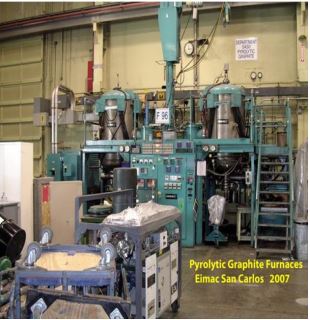
The soon to be scrap furnaces for PG production
A few years later they were sold for a pennies on the dollar in favor of using a smaller furnace because the CEO, Bob Fickett, decided it “looked nicer than the others,” a clear example of what sure looks like bad micro-management.
In 2016, as a result of poor maintenance, the last remaining PG furnace at CPI was destroyed in an explosion and it too was scrapped.
Without the ability to produce PG cups on-site as needed for power grid tubes, the need now to outsource grids makes the future of Eimac PG tubes very uncertain.
The last remaining CEC 817A transmitter, the one CEC sent to Eimac for evaluation, was still being used to test 4CX20,000 tubes, However, when the technician who had operated it since 1984 retired, it was scrapped because there was no one left who knew how to operate it.
Perhaps this story of the 4CX40,000G and the 4CX20,000E is one more piece of evidence that we now have reached the end of the tube era in broadcasting.
– – –
This is the third article in a series by looking at some of the famous and/or special tubes that were produced over the years by Eimac.
– – –
Reid Brandon (W6MTF) worked for Eimac’s tube division for 27 years, until his retirement in 2013.
Appendix
A couple of items you might find of interest follow:
1. A product announcement by John Allan, Eimac’s marketing manager, helped support the new 4CX20,000E:
The 4CX20,000E Power Tetrode.
The Eimac division of CPI is now delivering production quantities of the 4CX20,000E power tetrode for new FM transmitter construction as well as retrofits of transmitters now using the YC-130.
Available from Richardson Electronics, the 4CX20,000E is a ceramic/metal power tetrode intended for
use as a VHF power amplifier.
It features a type of internal mechanical structure, which results in RF operating efficiency. Low RF losses in this structure permit operation at full ratings to 110MHz.
The 4CX20,000E provides high gain in FM broadcast service and is also recommended for RF linear power amplifier service. The anode is rated for 20 kilowatts of dissipation with forced-air cooling and incorporates a compact, highly efficient cooler of new design.
Eimac vice president of marketing John Allan said the 4CX20,000E incorporated most of the features of the 4CX20,000C and was designed to mechanically fit into the same socket and chimney as the YC-130.
“We expect that customers will be pleased with the longer lifetime of this tube and the excellent performance in their transmitters,” he said.
Replacing the YC-130 in existing equipment will require a replacement of the filament transformer, as this tube operates from 10 volts, and a service bulletin for converting the Continental Electronics 816R is available on their website at www.contelec.com.
The YC-130 will also continue to be available, offering a choice of tubes to Eimac customers and supporting fielded transmitters.
Printed in SUPPLIER NEWS by Richardson Electronics, 09 May 2005
(NOTE: the photo used in that press release was of a 4CX20,000C not a 4CX20,000E)
2. A DATA SHEET FOR THE 4CX40,000G
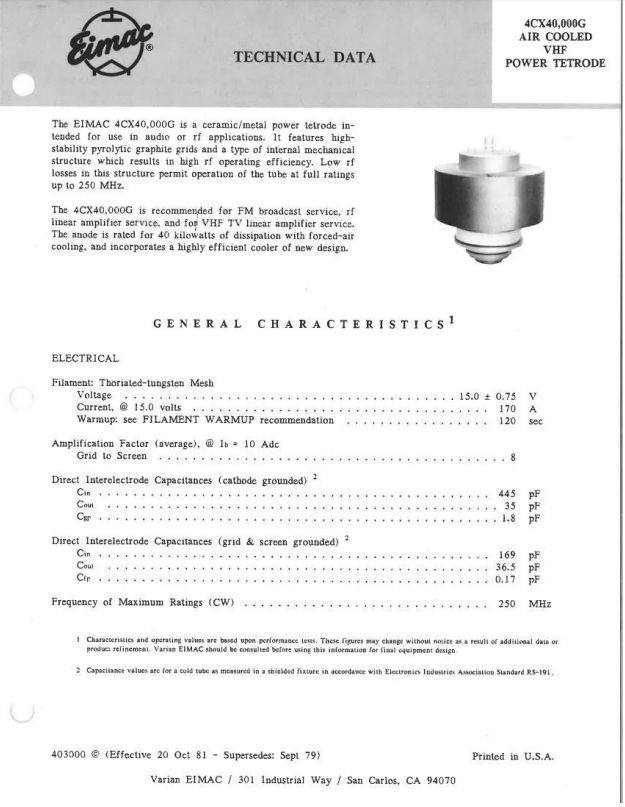
3. A DATA SHEET FOR THE 4CX30,000E
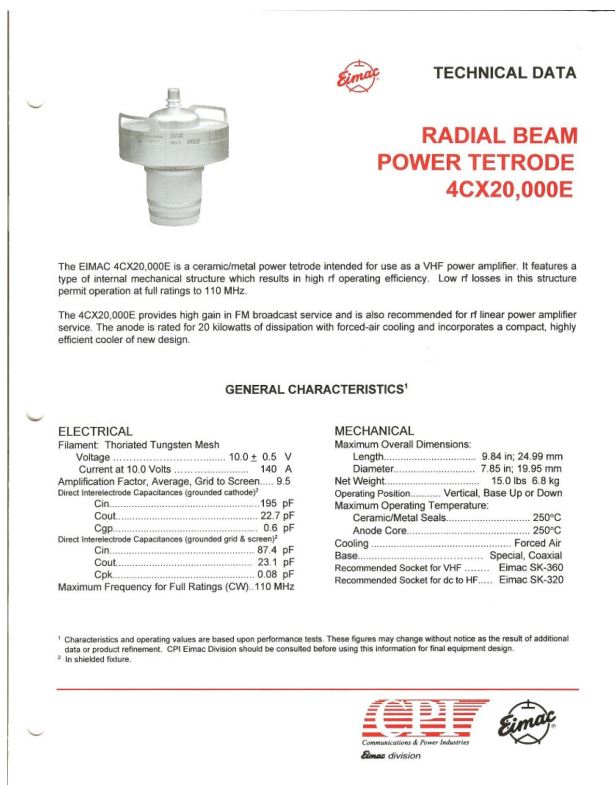
4. A DATA SHEET FOR THE 4CX40,000GM
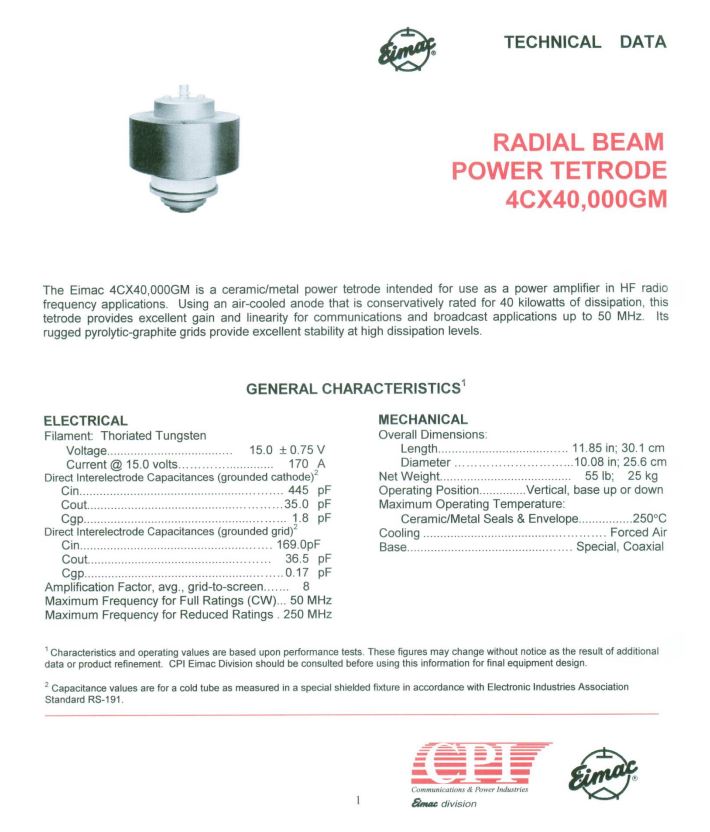
5. EVEN RICHARDSON ELECTRONICS GOT IN ON THE OPPORTUNITY TO SELL CONVERSION KITS FOR CEC TRANSMITTERS.
